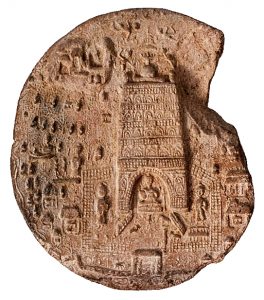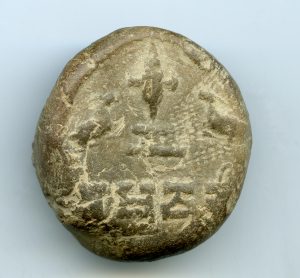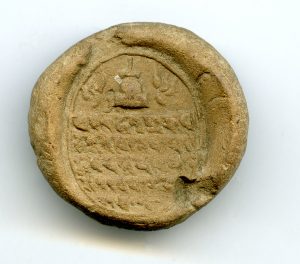OBBG00040 Pāṭaliputra plaque with Kharoṣṭhī inscription depicting the Mahābodhi temple

Pāṭliputra, Bihār. Terracotta plaque with Kharoṣṭhī inscription depicting the Mahābodhi temple in Bodhgayā. Photograph courtesy of the Bihar Museum.
INBG00040 Pataliputra Kharosthi inscription on Mahabodhi plaque
Pāṭaliputra, Bihār. Kharoṣṭhī inscription of Saṅghadāsa (INBG00040) on terracotta plaque depicting the Mahābodhi temple in Bodhgayā (OBBG00040). Edition here that of Konow (1926), see Concordance for bibliographic data.
OB01136 Plaque (votive). Wheel and flanking deer above the legend Ashtavriddha

Plaque (votive). Wheel and flanking deer above the legend Ashtavriddha. Made of impressed terracotta. British Museum 1883,1101.152.
IN01136 Plaque (votive). Wheel and flanking deer above the legend Ashtavriddha

Plaque (votive). Wheel and flanking deer above the legend Ashtavriddha. Made of impressed terracotta.
OB01135 Plaque. Stūpa above above the Buddhist ye dharmā formula

Plaque. Stūpa above above the Buddhist ye dharmā formula. Made of impressed terracotta. British Museum 1883,1101.146.
IN01135 Plaque. Stūpa above above the Buddhist ye dharmā formula

Plaque. Stūpa above above the Buddhist ye dharmā formula. Made of impressed terracotta
OB03104 In̆dikaṭusǟya Copper Plaques
Mihintale, Sri Lanka
IN03128 In̆dikaṭusǟya Copper Plaque Inscriptions
In 1923, ninety-one inscribed copper votive tablets were found among the ruins of the Indikatuseya stupa at Mihintale. The tablets were discovered by the Archaeological Department of Ceylon during the restoration and rebuilding of the dome of the stupa. It appears that they were originally deposited in the relic chamber but became scattered when the stupa was raided by treasure-seekers, which would also explain the presence of some Dutch stivers in amongst the medieval copper tablets. Most of the tablets are about 0.8 mm in thickness and are inscribed on one side only. Some bear traces of gilding. The majority are completely intact but a few are broken or have missing corners. On palaeographic grounds, they can be dated to the eighth or ninth century A.D. The inscriptions on the tablets are extracts from Buddhist texts of the Mahāyāna school. Indeed, forty-six have been connected with specific passages in the Pañcaviṁśati-sāhasrikā Prajñāpāramitā (nos. 1–46). A further fifteen have been found to quote from various passages in the Kāśyapa-parivartta (nos. 47, 48, 50–54, 57, 58, 61, 63, 67, 69, 76 and 79). The language of the inscriptions is Sanskrit but they are written in Sinhalese characters. The tablets are therefore significant epigraphical rarities, since there are few surviving examples from the medieval period that show the transcription of Sanskrit in Sinhalese script. However, the scribe does not appear to have been overly familiar with Sanskrit and, as a result, the inscriptions on the plaques often diverge slightly from their source texts.
